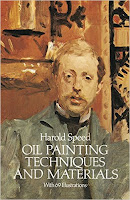
We continue the Friday Book Club with Chapter 2, "Modern Art" in Harold Speed's 1924 art instruction book
The Science and Practice of Oil Painting
.
Let's take Roberto's suggestion of breaking this chapter into two parts, so we'll stop at page 20. I'll present Speed's main points in boldface type either verbatim or paraphrased, followed by comments of my own. If you want to add a comment, you can use the numbered points to refer to the relevant section of the chapter.
1. "A considerable body of artists have deliberately set aside fine craftsmanship in order to express themselves more freely...there has been such a fashion for the crude methods of savages and primitive peoples."
Speed's racist comments, coming at the beginning of his book, have probably turned off a lot of readers to the useful material that comes later in his treatise on painting. That's unfortunate. But let's take a look at his views one by one and see whether there's anything that makes sense to us today.
England after World War 1 was seeing its empire rapidly eroding. Because of widespread press and travel, the doors were thrown open to an awareness of non-European cultures and art.
 |
| Andre Derain, The Dance, 1905-6 |
At the same time, Modern Art, which was primarily a European phenomenon, presented a direct threat to an artist with academic skills. The fact that Speed invokes "savages" and "primitive peoples" and he shows illustrations of African carvings is not altogether surprising since some of the European Moderns around Speed were called "fauvists" (which means wild animals). He was writing not long after the scandalous premieres of such works as
The Rite of Spring by Stravinsky, which deliberately evoked primordial rituals of non-European cultures.
 |
Ivory Coast, Spirit Spouse.
Wood, Ht: 18."
Baule ethnic group,
early 20th Century. |
I think most everyone nowadays would recognize that the art from non-European cultures—whether African or Pacific-Ocean or Native American — presents no threat whatsoever to traditional European academic painting. On the contrary, personally I find them hugely inspiring because of their language of abstraction.
In my mind non-Western art occupies a completely different category than Modern art does, despite the fact that many Modern artists used it as a jumping-off point. One can copy the outward style of any type of art, and that's totally fine. But if an artist doesn't know much about the culture or mind that produced that "exotic" art, it will be different from the original article.
Speed admits that some 19th century painters became overly concerned with naturalism, which he says led to "enfeeblement," so he has left the door open a bit to recognizing the value of Modernism.
Speed then proposes some sociological reasons for the rise of modernism:
2. Mass culture sets the dominant cultural note of the modern age
Speed suggests that there's a dominant cultural note in every age, such as that set by aristocratic patrons in the 18th century, and realism in the 20th century when middle-class values were in the ascendancy.
In other words, the power that
buys the art
shapes the art.
He then chalks up the trends of what he sees as crudeness in art to the rise of the power of the middle and lower classes. He says, "a great deal of the unrest and fretful violence that is disturbing the traditions of culture in all directions is due to the coming of this new cruder element into the cultural feast."
This argument strikes me not only as elitist, but wrong. If anything, it has been the cultural elite—especially academics, critics, and investors—that have promoted and supported Modernism.
Modernism has never been terribly popular in a widespread way among the lower and middle classes, compared to the art in comic books and magazines. What has truly captured the imagination of all socioeconomic classes in the West, from poor to rich, has been the "other" modern art movements found in comics, animation, and illustration.
3. "Now nobody waits until he has developed his mind before expressing an opinion."
What would he think of the Internet?
4. "The greatest works of art have been produced by small communities, such as existed in Athens and the independent states of Italy in the Renaissance."
Interesting point, and perhaps it has a grain of truth to it, but I'm not sure that's always true. I believe art of great quality can appear anywhere, including in commercialized mass culture.
5. "It is only those whose work shouts at you, who have much chance of any immediate notice."
Speed equates bright colors with swearing and other inflated forms of language. He raises an interesting question for our time: Can art with quiet, sober virtues find an audience in our own age of ubiquity and image overload?
Speed observes that as Modernism began to emerge, artists were interested in the exotic. He says, "Whistler, Aubrey Beardsley, Conder, and the exquisite decadent art of the
fin de siècle was the fashionable note. This has been followed by the craze for Cézanne, Van Gogh, Matisse, and Picasso."
He predicted that people would grow bored with such novelties. But history has proven otherwise, at least in the realm of the auction market and the museums. What may have surprised Speed were he to visit us today is how polymorphous the art world is. Whatever stuff you like, you'll find someone doing it.
6. "anaemic people painted life-size drinking the blood of freshly killed bullocks"
Speed makes reference to a specific painting at the (French?) Salon. Anyone know what painting he's referring to?
7. "I am not at all sure that the columns of literature it has produced, are not of much greater value than the works of which they are supposed to treat."
This is reminiscent of the point of Tom Wolfe's book
The Painted Word ,
, which argued that modern paintings serve primarily as illustrations of ideas that have their real life in print, and that the cart is driving the horse.
Tip to young artists: give critics and historians something to write about.
8. Quotes from Roger Fry on page 16 and 17.
Roger Fry was an interesting character in all this, a promoter of Post-Impressionism and a detractor of Sargent. Rather than try to explain him further, here's the
Wikipedia page on him.
9. "The great influence the Press has on modern life has brought into existence a new variety of artist, one who ministers to the demands of art critics."
There were publications cropping up everywhere in Speed's day which acted as tastemakers and gatekeepers. With those publications, Speed argues, comes a professional class of art critics who never existed before. He suggests that "the art-critics have strengthened their position recently by the control they have been able to exercise upon the purchasing departments of our public galleries."
Food for discussion:
a) There are still art critics in newspapers and magazines, but do they have the cultural influence they once did?
b) Has social media made art critics irrelevant?
c) What kind of artworks or artists are being fostered by the proliferation of forums like Facebook, Instagram, Twitter, and Blogger?
10. "Good craftsmanship is a healthier soil for art to grow in than fine theories about aesthetics."
This is a fascinating point, that art is the finest flower growing on a base of craftsmanship running through all of a culture's production. Can there be fine painting without a corresponding value placed on fine furniture and architecture and wallpaper and typography? This idea is reminiscent of William Morris, who believed that all things in a person's world should be conceived artistically.

We'll cover the second half, starting at "Technical Influences," next week.
-----




























